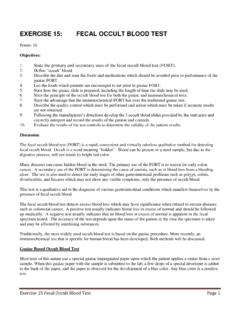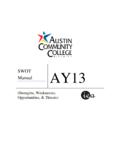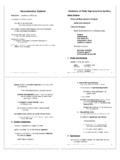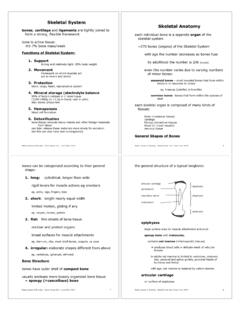Transcription of MLAB 1331: MYCOLOGY LECTURE GUIDE - Austin …
1 1 of 25 mlab 1331 : MYCOLOGY LECTURE GUIDE I. OVERVIEW OF MYCOLOGY A. Importance of MYCOLOGY 1. Introduction MYCOLOGY - the study of fungi fungi - molds and yeasts Molds - exhibit filamentous type of growth Yeasts - pasty or mucoid form of fungal growth 50,000 + valid species; some have more than one name due to minor variations in size, color, host relationship, or geographic distribution 2. General considerations fungi stain gram positive, and require oxygen to survive fungi are eukaryotic, containing a nucleus bound by a membrane, endoplasmic reticulum, and mitochondria. (Bacteria are prokaryotes and do not contain these structures.) fungi are heterotrophic like animals and most bacteria; they require organic nutrients as a source of energy. (Plants are autotrophic.) fungi are dependent upon enzymes systems to derive energy from organic substrates - saprophytes - live on dead organic matter - parasites - live on living organisms fungi are essential in recycling of elements, especially carbon.
2 3. Role of fungi in the economy a. Industrial uses of fungi (1) Mushrooms (Class Basidiomycetes) Truffles (Class Ascomycetes) (2) Natural food supply for wild animals (3) Yeast as food supplement, supplies vitamins (4) Penicillium - ripens cheese, adds flavor - Roquefort, etc. (5) fungi used to alter texture, improve flavor of natural and processed foods b. Fermentation (1) Fruit juices (ethyl alcohol) (2) Saccharomyces cerevisiae - brewer's and baker's yeast. (3) Fermentation of industrial alcohol, fats, proteins, acids, etc. 2 of 25 c. Antibiotics First observed by Fleming; noted suppression of bacteria by a contaminating fungus of a culture plate. d. Plant pathology Most plant diseases are caused by fungi e. Medical importance (1) 50-100 species recognized human pathogens (2) Most prefer to be free-living saprophytes; and only accidentally become pathogens (3) To be pathogenic, they must tolerate the temperature of the host site and possess enzymatic system that allows them to parasitize animal tissues.
3 (4) Increased incidence of fungal infections in recent times. 4. Importance of medical MYCOLOGY a. History During the time period between 1941 - 1973, the number of reported deaths in the due to scarlet fever, typhoid, whooping cough, diphtheria, dysentery and malaria decreased from 10,165 cases to 107; but the reported deaths due to mycoses during the same time period, increased from 324 to 530. b. Modern man (1) Increased mobility - Travel to a geographical area where a fungus exists as part of the commensal flora of the local population, or is endemic to the area. (2) The immunocompromised / immunosuppressed (a) AIDS (b) Drugs - tetracycline (acne); birth control pills; indiscriminate use of antibiotics; immunosuppressant drugs used in organ transplant patients, cancer and leukemia patients. (c) Environmental factors - air & water pollution; over processed & "fast" foods; fad diets etc.
4 (3) Ageing population c. Immunology of the Mycoses 3 of 25 (1) Antibody mediated immunity (B-cell humoral) (a) Antibodies are often produced in response to a fungal infection (b) Serological tests for identification of fungal diseases. (2) Cellular mediated immunity (T-cell) (a) T-cell immunity is effective in resistance to fungal infections. II. Definitions - basic terms as they relate to MYCOLOGY A. Basic Structures 1. Hypha (hyphae plural) - fundamental tube-like structural units of fungi . a. Septate - divided by cross walls b. Aseptate - lacking cross walls 2. Mycelium - a mass / mat of hyphae forming the vegative portion of the fungus a. Aerial - growing or existing in the air b. Vegetative - absorbs nutrients c. Fertile - bears conidia or spores for reproduction B. Spores Sporulation & Spores - preferred terms used when there is a merging of nuclear material / genes combine.
5 Fusion of nuclear material. Self-fertile = homothallic. Mating types = heterothallic. Sexual spores - fusion of nuclei 1. Ascospore - spore formed in a sac-like cell known as an ascus, the shape of which aids in identification of the fungus. Often eight (8) spores formed. (sexual). (Ascomycetes) 2. Basidiospore - sexual spore (union of two nuclei) produced on a specialized club-shaped structure, called a basidium. (Basidiomycetes) 3. Zygospore - a thick-walled spore formed during sexual reproduction in the Phycomycetes Asexual spores - most common type 4 of 25 4. Conidia - asexual fungal spores borne externally in various ways from a conidiophore; often referred to a macro- and microconidia. (Ascomycetes & Deuteromycetes). Macroconidia are multicellular Microconidia are unicellular 5. Arthroconidium (Arthrospore) - special type of asexual spore formed by disarticulation of the mycelium. 6. Blastoconidia / Blastospore - asexual spore formed from a budding process along the mycelium or from another blastospore.
6 (class Ascomycetes) 7. Chlamydospore - thick-walled resistant asexual spore formed by direct differentiation of the mycelium (concentration of protoplasm and nutrients) 8. Sporangiospore - an asexual spore contained in a sporangium at the end of a sporangoiphore of the taxonomic class Phycomycetes 9. Thallospore - asexual spore produced on a thallus (hypha). (Deuteromycetes) C. Miscellanous terms 1. Ascus - sac-like structure containing (usually eight) ascospores developed during sexual reproduction in the Ascomycetes. 2. Asexual reproduction - spores (reproductive bodies of a fungus) are formed directly from the vegetative mycelium or from specialized hyphae. 3. Chromoblastomycosis - a subcutaneous mycosis often the result of traumatic inoculation of a dematiaceous fungus into the skin; etiologic agents include species of Cladosporium, *Fonsecaea, Exophiala, & Phialophora 4. Coenocytic - a cell or an aseptate hypha containing numerous nuclei.
7 5. Conidiophore - a specialized branch of hypha on which conidia are developed. 6. Dematiaceous - pigmented, dark in color, usually gray to black. 7. Dermatophyte - fungi that cause superficial mycoses. 8. Diphasic (dimorphic) - the ability of some fungi to grow as either yeast or filamentous stages, depending on conditions of growth. 9. Ectothrixic - ability of the fungus to grow on the outside of a hair shaft. 10. Endothrixic - ability of the fungus to grow and penetrate into the hair shaft. 11. Endogenous - derived from internal source. 12. Exogenous - derived from external source. 13. Eukaryotes - organisms possessing a true nucleus (such as fungi ) as opposed to prokaryotes which do not contain a nuclear membrane (such as bacteria). 14. Fungemia - fungal blood infection 5 of 25 15. fungi Imperfecti - a large class of fungi with septate hyphae in which the asexual state of reproduction is known, but not the sexual state.
8 They are also called Deuteromycetes and include the majority of medically significant fungi . 16. Germ Tube - small projections which arise from cells of certain yeasts; indicates the onset of hyphal formation. 17. Hyaline - colorless, clear. 18. Mold - term generally referring to filamentous fungi 19. Mycetoma - a clinical syndrome of localized, tumorous lesions in cutaneous and subcutaneous tissues due to infections, often a foot, with actinomycetes or fungi . 20. Mycosis - a disease caused by a fungus 21. Mycotoxins - toxins of fungal origin 22. Oospore - also called zygospore, a sexual spore produced through the fusion of two unlike nuclei (class Phycomycetes) 23. Perfect fungi - fungi having sexual and asexual reproductive stages 24. Phycomycetes - a class of fungi forming a coenocytic mycelium with stiff sporangiophores that bear sporangiospores contained in a sporangium 25. Pseudohyphae - a chain of elongated budding cells that have failed to detach (not true hyphae) 26.
9 Ringworm - term used to describe circular or ring-like skin lesions produced by dermatophytes 27. Rhizoids - root-like structures 28. Saprobe (Saprophyte) - any plant organism that obtains its nourishment from dead organic matter 29. Sexual reproduction - zygote / spore formation follows the fusion of two haploid nuclei 30. Sporangiophore - a special aerial hypha or stalk bearing a sporangium 31. Sporangium - a sac or cell containing spores produced asexually 32. Spore - generally the reproductive body of a fungus; occasionally, a resistant body for adverse environment 33. Sterigmata - a specialized structure that arises from a basidium and supports basidiospores 34. Sporotrichosis - mycosis the result of inoculation with Sporothrix schenckii, lymphocutaneous type is most common 35. Telemorph - the sexual form of a fungus 6 of 25 36. Thallospore - spore formed by a change in portions of the thallus 37. Thallus - the vegetative body of a fungus 38.
10 Tinea (Ringworm) - Prefix used with the infected area of the body to indicate a cutaneous mycosis 39. Yeast - pasty or mucoid form of fungus growth, microscopically shows a predominance of budding cells 40. Zoophilic - dermatophytes which are parasitic on lower animals as well as man III. Classifications of fungi A. Geographic grouping Classification by geographic distribution. Certain fungal diseases are considered endemic to particular areas Histoplasmosis - Central Mississippi Valley and Ohio Valley fever Coccidioidomycosis - San Joaquin Valley fever B. Epidemiologic grouping Concerned with how fungal disease is transmitted. Few are contagious - ringworm of the scalp. Some are inhaled, others must be directly introduced into deeper tissue such as by a puncture from a thorn. Most mycoses are dependent on the susceptibility of the individual host. C. Taxonomy grouping Scientific grouping according to morphologic and cultural characteristics; varies somewhat, depending on author.










